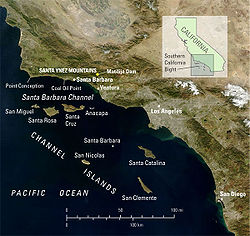- Coal Oil Point seep field
-
The Coal Oil Point seep field offshore from Santa Barbara, California is a petroleum seep area of about three square kilometers adjacent to the Ellwood Oil Field, and releases about 40 tons per day of methane and about 19 tons of reactive organic gas (ethane, propane, butane and higher hydrocarbons), about twice the hydrocarbon air pollution released by all the cars and trucks in the county in 1990.[1] The liquid petroleum produces a slick that is many kilometers long and when degraded by evaporation and weathering, produces tar balls which wash up on the beaches for miles around.[2]
This seep also releases on the order of 100 to 150 barrels (16 to 24 m3) of liquid petroleum per day. The field produces about 9 cubic meters of natural gas per barrel of petroleum.[2]
See also
References
- ^ J. Scott Hornafius and others, "The world's most spectacular marine hydrocarbon seeps (Coal Oil Point, California): quantification of emissions," Journal of Geophysical Research, v.104, n.C9, 15 September 1999, p.20,709, PDF file, downloaded 28 January 2009.
- ^ a b http://seeps.geol.ucsb.edu/ Hornafius et al.
Further reading
- Luyendyk, Bruce; James Kennett, Jordan F. Clark (2005). "Hypothesis for increased atmospheric methane input from hydrocarbon seeps on exposed continental shelves during glacial low sea level". Marine and Petroleum Geology (Elsevier) 22 (4): 591–596. doi:10.1016/j.marpetgeo.2004.08.005. http://seeps.geol.ucsb.edu/articles/2005%20Luyendyk%20et%20al%20JMPG.pdf. Retrieved 2009-01-17.
External links
Categories:- Petroleum geology
- Geography of Santa Barbara County, California
- Santa Barbara, California
- Nature reserves in California
- Ocean pollution
- Oil fields in California
- United States geology stubs
- California stubs
Wikimedia Foundation. 2010.

